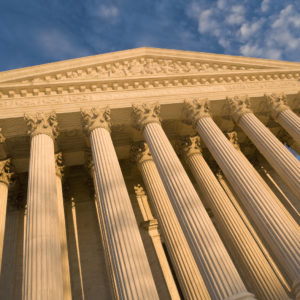Supreme Court observers are keeping a close eye on the court this session as it prepares to hear major cases on labor law, political speech, and the use of deadly force in police shootings. Attracting fewer headlines, however, are the cases involving Indian law that are appearing more regularly on the court’s calendar. These cases are significant for tribal rights groups, who have been struggling to preserve tribal sovereignty and jurisdiction in the face of legal rulings that have limited the areas over which tribal governments can exercise their authority. This term, the Court will decide three cases involving tribal rights: Upper Skagit Indian Tribe v. Lundgren, Washington v. United States, and Patchak v. Zinke. One case has already been heard before the court, while the other two are scheduled for oral arguments in the coming weeks.
Already, attorneys from the Native American Rights Fund and the National Congress of American Indians are remarking on how busy this term will be. The Court has already heard arguments in Patchak v. Zinke. This case arose when David Patchak, a non-Indian resident of Michigan, filed suit against the Department of the Interior, challenging its authority to take land into trust on behalf of a tribe. Patchak sued to try to prevent the tribe from building a casino on the land.
A prior Supreme Court ruling allowed Patchack to sue the Bureau of Indian Affairs for approving the tribe’s land to trust application. However, in the intervening period, Congress passed a law reaffirming the trust status of the land, essentially rendering the case moot. Patchak’s present suit challenges that law, arguing that the federal government “changed the rules” in the middle of the lawsuit.
“That is unconstitutional when, under the guise of changing the rules with respect to jurisdiction, the court is effectively deciding the case and then not letting the courts apply the new law either,” said Patchak’s attorney, Scott E. Gant during the oral arguments.
When the case was heard in November, Native American observers were optimistic that the case would be heard in the tribe’s favor, especially after Justice Neil Gorsuch asked bluntly “what’s the real beef here?” The case would have substantial impact on tribal rights in other pending land affirmation claims.
In late March, the Court will hear Upper Skagit Indian Tribe v. Lundgren, granting a petition in response to the tribe’s request, something that had been relatively rare. The case seeks to resolve inconsistencies between state courts on the issue of sovereign immunity. At heart, the case also involves land.
At the heart of the case is a parcel of property acquired by the Upper Skagit tribe in Washington State in 2013. As part of the process of submitting a land-into-trust application to the Interior Department, the tribe noticed a fence on the property. The adjacent landowners, Sharline Lundgren and Ray Lundgren believed that the fence, which had been in place for some 70 years, represented the boundary of the property and had been maintaining part of the land now owned by the tribe for years.
In their suit, the Lundgrens claimed that they own the land under adverse possession, or so-called “squatter’s rights.” Meanwhile, the tribe claims sovereign immunity, arguing that it cannot be sued without its consent.
Washington’s State Supreme Court ruled against the tribe, saying that tribal sovereign immunity need not be considered and expressing skepticism as to the legal remedies available to the Lundgrens if the tribe’s sovereign immunity argument required dismissal of the case.
“The tribe has wielded sovereign immunity as a sword in disguise,” Washington State Justice Charles W. Johnson wrote for the majority. “While we do not minimize the importance of tribal sovereign immunity, allowing the tribe to employ sovereign immunity in this way runs counter to the equitable purposes underlying compulsory joinder.”
Even so, when the court last heard a tribal sovereign immunity case in 2014, it ruled in favor of the tribe.
The final tribal rights case currently scheduled is Washington v. United States, which centers around treaty rights related to fishing. A decision by the 9th Circuit Court of Appeals found that Washington state had been violating treaties from 1854 and 1855 by failing to keep culverts around the state running clear. The clogged waterways, which often passed under state-managed roads, prevented salmon from returning to their usual and accustomed fishing sites.
The tribe has been concerned about the Supreme Court’s decision to hear the case since tribal interests have had a poor success rate in the past decade. Between 2006 and 2016, tribes lost in 9 out of 11 cases heard before the court.
Although the case has the potential to affect 21 tribes in the state, its impact is less than it might have been. Since the case was first filed, the bulk of the blocked waterways have been reopened. Out of the 1,000 culverts that were blocked when the case was first filed in 2011, fewer than 400 need repair today, according to the Northwest Indian Fisheries Commission.
“Instead of continuing to appeal the culvert case, tribes believe the state should use the momentum it has gained over the past four years to finish the job of fixing fish-blocking culverts, and focus on our shared goal of salmon recovery,” Lorraine Loomis, the chair of the commission, said in a statement.

